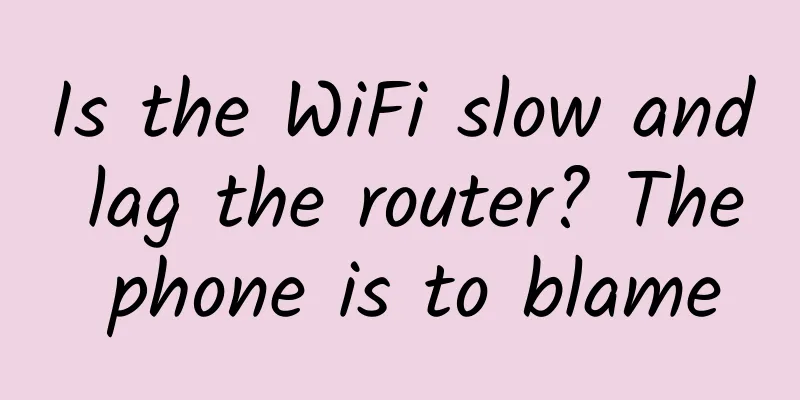Is the WiFi slow and lag the router? The phone is to blame

|
Under the guidance of the idea of increasing mobile data speed and reducing fees, the current mobile data pressure is far less than before. Take Beijing where I live as an example, the data provided by the operator every month is more than 20GB, plus the data can be accumulated for use in the next month, so there is really no shortage of data. However, when we use our mobile phones normally, we still subconsciously look for Wi-Fi. This has become our habit of using mobile phones and it is difficult to change it in a short period of time. There are actually many differences between Wi-Fi networks and the mobile data of our own mobile phones. The most fundamental reason why we pursue Wi-Fi is that it is free, while our own data traffic costs money. Take home Wi-Fi as an example. It relies on our home broadband. This part of the cost is a fixed rigid demand, and the data traffic is charged by the operator every month; Wi-Fi has no monthly usage limit, while data traffic has a usage cap. Relatively speaking, the use of Wi-Fi networks is more stable and also more power-saving; the stability of mobile networks is affected by signals and consumes more power.
Ultimately, we have greater trust in Wi-Fi networks. Even though the current gigabit-class 4G LTE network has surpassed home fiber broadband in terms of speed and stability, it still cannot stop us from looking for Wi-Fi. However, when using Wi-Fi, various problems may occur. For example, sometimes the connection is suddenly disconnected, or the connection is stuck or slow. We often think that it is the fault of the router or the network operator. After all, sometimes the router is down and we are forced to use data to access the Internet. If the phone is fine, then the problem must be with the router or the operator. However, we don’t know that network problems in Wi-Fi environments are often caused by our phones. The first blame: unreasonable resource utilization, MU-MIMO fills the gap We can see that routers on the market generally have 3-4 antennas, but our mobile phones or laptops and tablets generally only have 1-2 antennas. In addition, routers actually communicate with devices one by one, so our devices cannot fully utilize all network capacity, which results in idle waste of resources. For example, for a typical 4x4 SU-MIMO (Single User Multiple Input Multiple Output) router, its overall theoretical transmission rate on the 5GHz frequency band can reach 1.73Gbps. However, when connected to a traditional single-antenna wireless terminal, it can only achieve the transmission rate of a single stream, that is, the theoretical maximum rate is only 433Mbps, and the other 1.3Gbps of capacity will be idle at the same time. To solve the problem of idle resources, the Wi-Fi Alliance added MU-MIMO technology (Multi-User Multiple Input Multiple Output) to the 802.11ac second-generation standard, which greatly increased the efficiency of Wi-Fi networks. Compared with traditional routers that can only send multiple spatial streams to one device at a time, MU-MIMO allows multiple spatial streams to be assigned to different devices at the same time. The benefit is that the total network capacity is increased by 2-3 times, which also allows devices to enjoy faster Wi-Fi speeds. Let me explain this to you with the following chart. The left side shows the SU-MIMO situation. You can imagine that it is three smartphones, each of which is a 1 x 1 single-stream terminal, one is blue, one is green, and one is yellow. Because they are single-stream terminals, their total capacity is 350Mbps. They send in turns each time. For example, at the first time point, the router only transmits to the first terminal; at the second time point, the router transmits to the second terminal; at the third time point, the router transmits to the third terminal, so basically the total is 350Mbps, and each mobile phone only has 117Mbps. This is the case for most routers and mobile phones on the market. In the case of MU-MIMO, we can communicate with three terminals at any time, so that the entire network capacity reaches 910Mbps, and each terminal is about 303Mbps. In this example, MU-MIMO is 2.5 times better than SU-MIMO. This is a real improvement in mobile terminal performance. Qualcomm launched the MU-MIMO solution as early as 2015, and many routers on the market today support this technology. Therefore, if your home network always feels slow, stuck, or has high latency, you might as well pay attention to the router specifications and make sure to choose a router that supports MU-MIMO technology. Of course, communication is a two-way issue, and it works best when the router supports MU-MIMO and the phone also supports this technology. Even if the phone does not support MU-MIMO, it will benefit from the improved efficiency of MU-MIMO phones, because the improved efficiency gives the network more free time and capacity to serve these phones that do not support MU-MIMO. The second blame: The mobile phone antenna is not enough, the coverage is small and the signal is weak From the above analysis, we can see that MU-MIMO mainly solves the "traffic jam" problem caused by insufficient resource utilization in our network. Another problem we often encounter in Wi-Fi network environment is weak signal, slow speed and high latency. If you are also playing "King of Glory" recently, have you noticed that when you are in a corner of your home or there are several walls between you and the router, the upper right corner will turn red? Remember what we said above about the fact that mobile phones and tablets often only have 1-2 antennas? In more detail, in the past, mobile phones usually only had 1 antenna, which could only support single-antenna initial launch. This would not only lead to the waste of resources mentioned earlier, but also cause great problems in signal strength coverage and communication quality. Therefore, we need to add support for 2x2 MIMO to mobile phones. Mobile phones that support this technology can double the uplink and downlink rates by adding an antenna in hardware. Taking the above data as an example, in a MU-MIMO network, a single-antenna device can have a throughput of 303Mbps, so a 2x2 MIMO device can theoretically achieve a throughput of 606Mbps, greatly improving network capabilities. While ensuring the same throughput, 2x2 MIMO can achieve coverage over a wider range.
So if you want to improve your Wi-Fi network experience, you can change to a mobile phone that supports 2x2, which will definitely have an immediate effect. Such mobile phones are not difficult to find. Qualcomm, as the most commonly used processor solution in the current mobile phone market, has integrated support for 2x2 Wi-Fi in its Snapdragon 835 and 660 mobile platforms, and more than 100 terminal designs from leading manufacturers around the world and China are using this technology. Now we should understand why others can enjoy high-speed Internet smoothly under the same Wi-Fi environment, while you can only face the circle in the center of the screen. You spent thousands of dollars to buy the same mobile phone, but the difference in experience is so big just because of these two technologies that it is not worth it. |
<<: CDN price war aside, P2P regains attention. Who is the driving force behind this?
Recommend
LOCVPS: 30% off on CN2 line KVM in the Netherlands, 2G package renewal in Tai Po, Hong Kong, starting from 44 yuan per month
LOCVPS (Global Cloud) is an early established Chi...
Cisco ushers in a new era of networking
The recent WannaCry ransomware cyberattack target...
Application scenarios are becoming increasingly diversified, and my country is accelerating the development of blockchain technology
my country has the world's largest Internet a...
How much power does 5G base stations consume? It is expected to account for 2.1% of the total electricity consumption in society
As we all know, since the first half of the year,...
JuHost: Hong Kong Kowloon VPS 40% off from $2.99/month, Japan VPS 30% off from $3.49/month
JuHost is a foreign hosting service provider esta...
Why is the VR panoramic industry rising?
It has been some time since 5G was commercialized...
[Christmas] DMIT: $100/year-2GB/40G SSD/2TB@2Gbps/Los Angeles CN2 GIA
DMIT has released two special Christmas packages,...
5 things you should know about monitoring tools
Does your IT team have too much data and not enou...
Understand the ins and outs of DNS in one article
[[333115]] 1. Background By the late 1970s, the A...
WeChat's biggest competitor is coming! The three major operators are all working on 5G, and news is coming soon
5G messaging, which is regarded by the industry a...
How to cut data center costs without sacrificing performance?
While organizations are placing greater demands o...
Tencent: Fully opening up 5G capabilities to build a "new connection" in the digital era
As an important part of the new infrastructure, 5...
How to use Layer 3 switches to build enterprise VLANs
The expansion of enterprise scale has led to the ...
The Ministry of Industry and Information Technology has issued an "iron order" that if you want to port your number to another network, you must meet these three conditions!
As we all know, the three major operators are amo...
Various technical measures to eliminate data center hot spots
According to a study by the Uptime Institute, up ...









